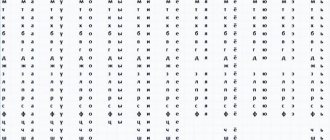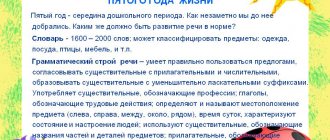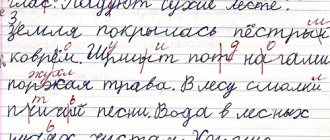Have you ever encountered the following situation? We check the child’s writing notebooks and notice a huge number of errors. This is not necessarily a sign of laziness or illiteracy, because there is such a disorder of written speech and mental functions of the brain as dysgraphia in children
The concept of dysgraphia as a disorder of written speech
What is dysgraphia?
In one of the previous articles we discussed the topic of dyslexia. It was also said there that these are similar developmental disorders, and they almost always overlap, but do not always accompany each other. In Russia, while receiving primary education, more than thirty percent of primary school students have this deviation, so the disorder is common and it is very important to learn to recognize it, understand its causes and know ways to overcome such a problem.
Dysgraphia is a written language disorder in which obvious errors are made when writing and which requires speech therapy correction.
Like dyslexia, dysgraphia has several forms, each of which has its own characteristics, and, more precisely, its own examples of errors made by children. The following forms of dysgraphia can be distinguished:
- Acoustic
- Articulatory-acoustic
- Optical
- Ungrammatical
- Dysgraphia associated with non-perception of language analysis and synthesis
What is phonemic awareness
Human physical hearing, that is, the ability to perceive and distinguish the sounds of the surrounding world, is divided into three types: non-speech hearing, phonemic and musical hearing.
Phonemic awareness is a person's ability to recognize and distinguish phonemes in a stream of speech. The ability to compare, analyze, synthesize and relate sounds to their standards.
A child is endowed with physical hearing from birth; phonemic hearing is formed in the process of upbringing. Normally, it should be formed by the age of 5, provided that the child is in a favorable speech environment. Very young children cannot yet distinguish sounds that are similar to each other, but if adults speak to him in the correct language, do not lisp, correct him, read books and learn poetry, then success is guaranteed.
If phonemic hearing is impaired for one reason or another, a child after 4-5 years of age continues to have incorrect sound pronunciation and a violation of the syllabic structure of the word. Later, this problem spreads with the child to school, affecting written speech, and is called dysgraphia. Dysgraphia is expressed in persistent errors when writing words and sentences, for example, rearranging syllables in a word, replacing one sound with another. Therefore, when a problem is discovered, it is very important to begin work on developing phonemic hearing in preschool age.
Symptoms of dysgraphia in a child
Phonemic perception
This form of written language impairment involves the presence of poor phonemic awareness. When practicing writing, one replaces some with other letters that denote similar sounds. For example, replacing paired consonants “b” / “p”, “d” / “t”, “g” / “k”, consonant vowels “o” / “u”, “e” / “yu” or complex sounds and their components “a” / “i”, “ts” / “s”, “ts” / “t”, “h” / “shch” and so on.
In case of acoustic dysgraphia there are no problems with hearing and oral speech
.
Errors in pronunciation of sounds
In this case, the symptoms described above remain, only errors in the pronunciation of sounds are added to acoustic dysgraphia. In fact, this is a combination of acoustic and phonemic dyslexia. The child reads and writes words incorrectly and confuses similar sounds.
Articulatory-acoustic and articulatory disorders occur in children with phonetic-phonemic speech disorders.
Agrammatic speech disorder
There are difficulties in pronouncing text that has been read and is due to unformed speech. The student writes and pronounces without fully realizing syllabic perception and the meaning of the formation of words. It is difficult for him to find synonyms or antonyms, to describe something correctly, or to form the necessary form of a word (for example, a diminutive or plural). There may also be difficulties in constructing complex sentences (for example, he omits one or another member of a grammatical sentence or violates the rules of their sequence). Agrammatic dysgraphia is often found in bilingual families.
Optical dysgraphia of writing
In this case, the child's brain confuses visually similar letters. He can add or remove elements of letters, as a result of the formation of words, both existing and non-existent signs are obtained. For example, you can confuse “X” and “F”, “A” and “L”, and from the letter “E” you can make “S” in reverse. Also, sometimes with optical dysgraphia, letters are mirrored.
Underdevelopment of language analysis and synthesis
Despite the complex name, this type of dysgraphia is quite simple to identify. A student suffering from it, in the process of writing, misses letters or syllables, changes their places, duplicates or even adds something that is not there. Also, a student may confuse in written work where a space is needed and where not, or not complete words. There are also difficulties in defining the boundaries of the proposal.
Learning letters
| Letters by ear | Collect words | Letters by sound |
| Repeat the letters | Recognize letters | Lexicon |
What is dysgraphia in children?
Primary school teachers know from their work experience that there may be up to 30% of students in a class who have various writing disorders. The process of writing, which is automatic in an adult, causes many problems in a child. Writing is a complex form of speech activity, a multi-level process. It involves speech-auditory, speech-motor, visual, and general motor analyzers. A close connection is established between them in the process of writing. Writing is closely related to oral speech and the degree of its development. It is based on the ability to distinguish speech sounds, isolate them in the flow of speech and connect them, pronounce them correctly. To write a word, a child needs:
- determine its sound structure, sequence and place of each sound;
- correlate the highlighted sound with a certain image of the letter;
- reproduce the letter using hand movements.
To write a sentence, you need to mentally build it, speak it, maintain the required writing order, break the sentence into its constituent words, and mark the boundaries of each word.
If a child has impairments in at least one of these functions: auditory differentiation of sounds, their correct pronunciation, sound analysis and synthesis, lexico-grammatical side of speech, visual analysis and synthesis, spatial representations, then a disturbance in the process of mastering writing may occur - dysgraphia ( from the Greek "grapho" - writing). Dysgraphia is a specific disorder of written speech, manifested in numerous typical errors of a persistent nature and caused by the immaturity of higher mental functions involved in the process of mastering writing skills. How to determine whether a child needs help from a speech therapist? And if, due to various circumstances, there is no specialist and a teacher or parent cannot receive qualified advice. How to help a child in this situation? First, it is necessary that the primary school teacher (parent) knows which errors are specific, dysgraphic. Classification of dysgraphic errors. Errors caused by immaturity of phonemic processes and auditory perception:
- missing vowels; all-hanging, room-room, harvest-harvest;
- omissions of consonants: komata-room, wey-all;
- omissions of syllables and parts of words: arrow lines;
- replacement of vowels: food-food, sesen-pine, light-light;
- replacement of consonants: tva-two, rocha-grove, harvest-harvest, bokazyvaed-shows;
- permutations of letters and syllables: onko-window;
- underwriting of letters and syllables: through-through, on a branch-on branches, dictation-dictation;
- building up words with extra letters and syllables: children-children, snow-snow, dictation-dictation;
- distortion of the word: malni-small, teapot-thicket;
- continuous spelling of words and their arbitrary division: two-two, strike-clock-strike, in all-all;
- inability to determine the boundaries of a sentence in a text, writing sentences together: Snow covered the entire earth. White carpet. The river is frozen and the birds are hungry. - Snow covered the entire earth with a white carpet. The river froze. The birds are hungry.
- violation of mitigation of consonants: big-big, just-only, sped off-rushed off, mach-ball.
- Errors caused by unformed lexical and grammatical aspects of speech:
- violations of word agreement: from a spruce branch - from a spruce branch, grass appeared - grass appeared, huge butterflies - huge butterflies;
- violations of control: in the branch - from the branch; rushed to the thicket, rushed into the thicket, sitting on a chair, sitting on a chair;
- replacing words based on sound similarity;
- continuous writing of prepositions and separate writing of prefixes: grosche - in the grove, wall - on the wall, on the booze - swell;
- missing words in a sentence.
- Errors caused by unformed visual recognition, analysis and synthesis, spatial perception:
- replacement of letters that differ in different positions in space: sh-t, d-v, d-b;
- replacement of letters that differ in different numbers of identical elements: i-sh, ts-sch;
- replacing letters that have additional elements: i-ts, sh-shch, p-t, x-zh, l-m;
- mirror spelling of letters: s, e, yu;
- omissions, extra or incorrectly positioned letter elements.
- Errors caused by children’s inability to assimilate a large amount of educational material, remember and use orally learned spelling rules in writing:
- unstressed vowel at the root of the word: vada-water, chisy-hours;
- spelling of voiced and unvoiced sounds in the middle and at the end of a word: tooth-tooth, doroshka-path;
- denotation of softening of consonants;
- capital letter at the beginning of a sentence, in proper names.
Recently, another group of errors has been identified, which are considered necessary to be classified as dysgraphic if they are persistent. They say about children who have this type of error: “As they hear, so they write.” The classification of errors is based on the reasons for their occurrence. This will help the teacher (parent) both to identify the causes of difficulties and to correctly identify the type of violations in the writing process and plan work to overcome these violations.
Types of writing disorders in children
In the specialized literature there are various classifications of dysgraphia, but they are all based on the causes of the disorders. Let us highlight the following types of violations of the writing process:
Articulatory-acoustic dysgraphia in children
The cause of this type of disorder is incorrect pronunciation of speech sounds. The child writes words the way he pronounces them. That is, it reflects the owl’s defective pronunciation in writing.
Acoustic dysgraphia (based on phoneme recognition, phoneme differentiation)
The cause of this type is a violation of differentiation and recognition of close speech sounds. In writing, this is manifested in the replacement of letters denoting whistling and hissing, voiced and deaf, hard and soft (b-p, d-t, z-s, v-f, g-k, zh-sh, ts-s, ts -t, h-sch, o-u e-i).
Dysgraphia due to disorders of language analysis and synthesis
The reason for its occurrence is difficulties in dividing sentences into words, words into syllables, sounds. Typical errors:
- consonant omissions;
- vowel omissions;
- letter rearrangements;
- adding letters;
- omissions, additions, rearrangements of syllables;
- continuous spelling of words;
- separate spelling of words;
- combined writing of prepositions with other words;
- separate spelling of prefix and root.
Agrammatic dysgraphia
The reason for its occurrence is the underdevelopment of the grammatical structure of speech. In writing, it manifests itself in changes in case endings, incorrect use of prepositions, gender, number, omission of sentence members, violations of the sequence of words in a sentence, violations of semantic connections in a sentence and between sentences.
Optical dysgraphia
The cause of occurrence is the immaturity of visual-spatial functions. It manifests itself in substitutions and distortions in writing of graphically similar handwritten letters (i-sh, p-t, t-sh, v-d, b-d, l-m, e-s, etc.). Having determined the type of violations of the writing process, you can outline the main directions of work with the child.
| List the letters | Coloring pages | Learning letters using Doman |
| Syllable table | Number coloring pages | Online copybooks |
| For kids Memorizing the alphabet The more you play, the better you remember the words | Warehouse reading Find the encrypted word Adding letters into words | Accelerating reading Learning to read with ease Reading fluently |
Letter coloring pages for children to learn to read
The transfer of values and means of an active attitude towards the world can only be carried out taking into account the age of children and their psychological characteristics. Due to the specifics of age, the duration of one lesson is 30 minutes, the frequency of classes is twice a week.
Each lesson begins with a warm-up. Children perform exercises to strengthen the muscles of the back, or abdominals, or the muscles of the hand and neck. In order for children to perform general developmental exercises with interest, we beat them. When conducting classes, teachers use exercises to develop imagination, asking children to create different images. To create a given image, a child needs to apply his life experience, make a certain effort, work hard, and master specific skills. The assimilation of these skills is associated with the improvement of such volitional personality traits as perseverance, endurance, voluntary attention, accuracy, and independence.
Classes as a form of organizing learning are most often characterized by the completeness of this process: the presence of the main links of learning and stages of mastering knowledge, skills and abilities. Mastering new material occurs on the basis of reproducing previously learned material, directly adjacent to the new one. New material is given in small parts. During one lesson, both the primary perception of new material and its comprehension, assimilation of knowledge, skills and abilities are carried out. Only such repeated perception of knowledge in various activities and different conditions ensures the completeness of the formed ideas.
2 years is probably too early for syllables. Learn the rest of the letters for now. We're 2.5. He speaks well and knows the entire alphabet. It’s not working with syllables yet...But we’re trying. I write large MOM, DAD, BABA, pronounce them syllable by letter, separately by letter. By the age of four, it is quite possible to teach reading... The talking alphabet is really a good thing. Letters on magnets are also an option.
Smeshariki teach letters to children 3,4,5 years old
if you get up before 7.30-8.00. Having breakfast and starting to study at home at 9.00, the child studies better, is more active, and is less distracted. But if I sleep longer, I’ll spend the entire lesson “pulling and persuading” him. And classes should be short for 10 minutes, then rest for 5 minutes and again. Another activity. Have you tried going to development school? There are small groups of 5-8 people. And teachers. And select literature according to age. Nowadays there are a lot of training manuals, so it’s not a problem to organize a lesson at home.
Why do parents think? If a child can read, then he is a genius. The main thing is to develop the child’s speech and memory (poems, songs). And the most important thing is the development of fine motor skills. And this: collect mosaics, puzzles, sculpt, draw. And they will teach him to READ at school. Or he himself will learn in the game for years to If you overdo it now, then later there may be a period of inhibition. If you want to develop a child, then develop according to age, taking into account psychophysiological development. Colors (up to 3 must know all the basic ones), Animals (classification - wild or domestic), Ability to retell a fairy tale, Tell a story using pictures, and many others. A child must first understand the diversity of the world around him, and only then learn to read about it. For him, any reading is like reading Hamlet at 6 for you. Why bully a child? The ability to read is by no means an indicator of the development of a child’s intelligence and personality.
Until the age of 4, this is not necessary; it is better to teach colors, animals, plants, and the surrounding world; the child will not be able to perceive both. And in general, I think that it’s easier to learn according to Glen Doman’s system; you learn words instead of letters.
Consonants of the Russian language and teaching children to read
2 years is probably too early for syllables. Learn the rest of the letters for now. We're 2.5. He speaks well and knows the entire alphabet. It’s not working with syllables yet... But we’re trying. I write large MOM, DAD, BABA, pronounce them syllable by letter, separately by letter. By the age of four, it is quite possible to teach reading... The talking alphabet is really a good thing. Letters on magnets are also an option.
Until the age of 4, this is not necessary; it is better to teach colors, animals, plants, and the surrounding world; the child will not be able to perceive both. And in general, I think that it’s easier to learn according to Glen Doman’s system; you learn words instead of letters. the main thing is not to be wrong. Buy Zhukova’s primer, at least there are explanations for parents on how to teach children to read. Otherwise you will have to relearn it later. Source: We also started reading early. For your age, knowing 10 letters is already a lot. Don’t overload your child’s brain—he’s not ready for it yet. Learn better nursery rhymes of 4 lines - this helps develop memory, names of colors.
Why do parents think? If a child can read, then he is a genius. The main thing is to develop the child’s speech and memory (poems, songs). And the most important thing is the development of fine motor skills. And this: collect mosaics, puzzles, sculpt, draw. And they will teach him to READ at school. Or he himself will learn in the game for years to If you overdo it now, then later there may be a period of inhibition. If you want to develop a child, then develop according to age, taking into account psychophysiological development. Colors (up to 3 must know all the basic ones), Animals (classification - wild or domestic), Ability to retell a fairy tale, Tell a story using pictures, and many others. A child must first understand the diversity of the world around him, and only then learn to read about it. For him, any reading is like reading Hamlet at 6 for you. Why bully a child? The ability to read is by no means an indicator of the development of a child’s intelligence and personality.
Don’t rape the child, have mercy, he’s still small. I tried to drill it into mine in exactly the same way, I was worried, not realizing that the brain was not yet ready to perceive reading. And when the time came, he himself put all the letters into syllables and words. The main thing is to detect this period in time and then it will start. And at this age you can simply instill a hatred of reading and everything connected with it.
A child does not need an alphabet. Has it been useful to you in life at all or what? Everyone uses letters and sounds, but the alphabet is an assignment for school. There is a huge mistake in this video - they teach letters instead of sounds. With such science, a child will not begin to read soon, since it takes a lot of ingenuity to divide the letter “Se” and, by removing the excess from it, get the sound “s”. If your child is under 5 years old, throw away this video. Or you will be told the alphabet and letters before school, but reading will be limited to words like “mom” and “dad”.
Poems about letters for children to memorize letters
How does a bee buzz? You ask the child: Have you heard the bees buzzing? Try buzzing too - LJJ. Now let's talk in bee language, as if we were two bees. Like this: “Let's be friends! Where do you live? And I Live in this Live Housing. Come visit me, I’ll treat you to some ice cream.” To extend the sound B, you can play out the meeting of two cars: I VVVvozh oVVVegetables, and what do you VVVVozhite? Do you know how to turn left? And to the right? YesVVVVVVVVVVVvet we will arrange a competition - who will start VVVVVVV better. BBB... By playing “a conversation between two steamships”, the child will learn to draw out the sound U. Emphasizing the sounds Ш and С in words, invite the baby to talk like snakes. When the child learns to draw out, strengthen, and sing individual sounds in words, make the task more difficult for him: What sound does the word “fly” begin with? Stretch out that sound. Is there an M in the word “house”? In the word "wall"? What other words can you name that start with the sound M?
Causes of impairment of writing and speech reproduction of information
Why does a child write poorly or why does a child read poorly? Not surprisingly, the causes of dysgraphia are similar to the causes of dyslexia.
- Hereditary predisposition
- Diseases suffered during the perinatal period of development, as well as various complicating factors (bad habits of the mother, complicated toxicosis, asphyxia, short interval between the mother’s pregnancies, and so on)
- Internal functional reasons (long-term somatic diseases, etc.)
- External functional reasons (improper speech education)
- Lack of school readiness for writing
- Minimal brain dysfunction
- Impaired mental function
- Attention Deficit Hyperactivity Disorder
- General speech underdevelopment
- Impaired pronunciation of speech (dysarthria)
- Strokes, traumatic brain injuries, neurosurgery and brain tumors (possibly in adulthood)
Dysgraphia, like dyslexia, can lead to many problems. Among them are a drop in educational motivation, underdevelopment of speech, school failure, undeservedly poor performance, and so on. Therefore, it is very important to realize that it is not the child’s fault that he writes incorrectly, and this problem is not related to his schooling.
Responsibility for correcting the violation lies, of course, with specialists, but first of all, with parents!
As well as the process of development of their pet as a whole. All that is required of teachers is to recognize the violation in time and provide conditions in the classroom that promote the harmonious development of children, including the correction of dysgraphia.
But is it possible to confuse dysgraphia and other developmental disorders?
How not to do this?
Diagnosis of dysgraphia disorder by a speech therapist
Unfortunately, you will not be able to make a diagnosis and therefore contact a medical center. It is necessary to carry out a process of speech analysis of written grammar. You will have to undergo diagnostics and examination by a number of specialists, among them: a neurologist, an ophthalmologist, an otolaryngologist, a speech therapist and a psychoneurologist (the latter, in fact, make the final diagnosis). Each of the doctors checks whether the subject has any health problems that could lead to a disruption in the writing process, in addition to dysgraphia. Let's assume that the diagnosis has already been made. The main question that faces us now is how to deal with dysgraphia in a child?
The child misses letters when writing
Some parents encounter a problem when their child misses letters when writing. We want to tell you about how to help your child. We want to talk about how to help a child with writing and reading disorders.
Mastery of language, accurate, correct oral and written speech is a necessary condition for the formation of a successful personality. This important task faces both parents and teachers and speech therapists. It can only be resolved through close cooperation. The role of the speech therapist is especially important in the implementation of the task if the child has impairments in oral and written speech. Currently, there is a sufficient amount of literature on overcoming sound pronunciation disorders. Unfortunately, a violation of one structural component of the speech system entails secondary and tertiary disorders. Among them, as a rule, are general underdevelopment of speech, disturbances in the processes of reading and writing, disturbances in memory, concentration, verbal and logical thinking, etc. Teaching children to read and write is not an easy task. And not all children are given these, in the opinion of adults, basic things easily and simply.
Teaching children letters and syllables. Reading for children 3,4,5 years old
A child can be in many ways smarter and more talented than his peers - and make the most incredible, from the point of view of his parents or teacher, mistakes in reading and writing. For example, skip letters: chsi – hours; Write all words or prepositions with words together; make two words from one word: ok and but – window, etc. Unfortunately, many parents, and sometimes teachers, attribute these mistakes to inattention. At best, the teacher recommends that parents write more dictations with their child. And then a difficult period begins for both parents and children. The child develops a negative attitude towards writing, towards the subject, towards school. To avoid this, analyze your child’s mistakes. If such “ridiculous” mistakes are not random, but are repeated regularly, then the child should seek advice from a speech therapist. The presence of persistent errors of this type indicates that the child has a partially impaired writing process - dysgraphia.
Work on dysgraphia correction with a speech therapist
Any doctor will tell you that self-medication is unacceptable, and this is true.
Basically, a speech therapist works with dysgraphia, but a neuropsychologist, a psychotherapist, and an educational psychologist can also work.
You should prepare for the fact that the process of eliminating speech and writing disorders will not be quick. The correction program is built depending on the causes, type of violation and age characteristics. The older he is, the more difficult it is to carry out the correction.
Cases when medication or physiotherapeutic treatment is necessary
If there is an organic cause of dysgraphia, then its treatment will be prescribed (medication, physiotherapy, and so on). Similar methods of treatment are prescribed for aggravated disorganization of written speech, leading to the impossibility of writing (Agraphia). Various exercises will be carried out with a speech therapist. You can apply some of them yourself and work with your child at home, in this way you will not only help with the correction, but also get closer to your baby.
Exercises to correct dysgraphia at home
Is it possible to correct and how to correct dysgraphia at home? Yes, after consultation with a speech therapist and his analysis of the situation, the main burden falls on doing the exercises at home. Below are exercises for correction. You can apply them and practice them yourself. This way you will not only help the correction, but also get closer to your baby.
"Labyrinth"
You need to go through the labyrinth by drawing a continuous line on a piece of paper without lifting your hand or turning the labyrinth.
Graphic dictations
These are tasks in which you need to draw something on a checkered sheet of paper based on prompts. There are graphic dictations in which a letter or number must be obtained.
Construction of signs from elements
You can make letters and numbers from different objects: counting sticks, pencils, cereals, plasticine, and so on. You can draw drawings on paper in the form of signs. From already composed symbols, you can recompose them. Take them apart and put them back together.
Schulte tables
Schulte tables, the Munstenberg technique and other psychological methods for developing attention related to numbers. According to psychologists, this is especially effective when the child is between 10 and 11 years old.
Crosswords
Scanwords, crosswords, English crosswords, Sudoku and other puzzles.
Recognizing incomplete notations
Play recognizing letters and numbers that are not fully drawn. Let the child add the part of the sign that is missing. Some designs can be continued into several different symbols. For example, the letter “B” and the number “5” have a common part.
Finding missing letters in a word
Write a word and deliberately leave out a letter or even a syllable. Let the student analyze the word, find gaps, highlight the syllable, correct the mistake and name the correct spelling.
Memorizing poems
This is also a kind of exercise that develops memory and speech. In our case, poetry will help us gain a sense of rhythm in speech.
Play with words
Make anagrams: rearrange letters and syllables in words so that they form new words or phrases. You can also take some medium or large word and try to make words from the letters in it. There are a lot of similar techniques.
Development of fine motor skills
It seems that everyone around is already repeating this: the development of speech is associated with fine motor skills. Make the most of this opportunity: let the child’s psyche take a break from the Russian language, and let him take up modeling, beads, construction sets, origami and other interesting activities. Turn on your imagination - and you will succeed. In addition, it will be extremely interesting for both you and the child!
Psychological comfort when writing
You must provide your pupil, first of all, with psychological comfort, because without it the problem will either not be solved, or will be solved, but with consequences of a different nature. Fear of the teacher, hatred of writing and lessons, shame in front of classmates and more.
- Talk to teachers. Explain the seriousness of the situation and ask them to behave competently. Let them not focus the attention of other children on the problem and be patient. The teacher's duty is to treat his student with understanding. This means helping, stopping the ridicule of others and not scolding for mistakes. A teacher who does not understand this can not only interfere with the correction of dysgraphia, but also lead the student to nervous overstrain. Just imagine the situation. You are a small child of 8 years old who cannot do what all girls and boys do with ease. At the same time, an adult, a teacher with whom you often have contact, scolds you for writing mistakes, and meanwhile your peers ridicule them. And this continues for quite a long time, day after day. I think it is obvious that the little person will have neither educational motivation, nor trust in others, nor healthy self-esteem.
- Charge your child only with positive energy. Praise your child for successes more often and do not talk about bad things. It is very important that he believes in himself and does not give up, that is, does not stop doing writing exercises just because he is tired or something does not work out. At the same time, do not force him to overwork: everything should be in moderation. Otherwise, breakdowns cannot be avoided. Remember that parents are the most important thing your son or daughter has. They are his best friends and the closest people in his life. Who, if not you, will support your child in achieving success?
What is important to know about dysgraphia
- Dysgraphia is the most likely consequence of dyslexia. Since the child first reads and then writes, the difficulties that manifest themselves in reading are transferred to problems in writing. He first reads incorrectly and then writes incorrectly.
- Pathologies can also occur in adults. If corrective work is not carried out on time, then these speech and writing disorders can remain with the person for life. Accordingly, they will cause him more problems.
- Sometimes correction of dysgraphia is a long process. Parents need to be prepared for the fact that sometimes correction of dysgraphia, dyslexia and other related speech disorders may take more than one month or even one year, but several years. Willpower and patience will be required.
- If you have questions about how to treat dysgraphia, then dysgraphia is not a disease. And not even a mental disorder. This is only a disorder of speech development associated with the functioning of the brain. Therefore, it would be incorrect in this case to use the words “treatment”, “sick”, “disease” and others. However, it is also inappropriate to assume that this will “go away on its own.”
- Dysgraphic handwriting may be unclear. This is often associated with a violation of the motor and visual analyzers, so a child suffering from this may write illegibly and crookedly.
Risk groups for dysgraphia
There are certain risk groups for children who may develop dysgraphia.
Therefore, doctors must first diagnose and analyze the child’s sound pronunciation in the following cases:
- If he comes from a multilingual family;
- Previously had diseases of the hearing and speech apparatus;
- Left-handed or ambidextrous (a person for whom the left and right hands are equivalent);
- He started talking late;
- Left-handed, who was retrained to be right-handed;
- With disorders of phonetic perception;
- Has memory or attention problems;
- A student with a low level of school readiness;
- He writes as he speaks;
- Makes a small number of mistakes typical of dysgraphics.
Child's interest in writing
Games will help to interest the child. This is especially true if preschool children have dysgraphia.
If a child does not want to correct the violation and neglects written work, then exciting games will come to the rescue.
With your support, correction of dysgraphia will turn from backbreaking work into leisure.
Development of mental functions
The development of mental functions will help correct speech disorders at the initial stage. Activities for the development of fine and gross motor skills, attention, memory, thinking, intelligence, phonemic hearing, musical hearing, spatial perception, emotional-volitional qualities and other things - this is something that will be of great benefit in preventing difficulties with speech and the occurrence of distortions in recognizing the structure of the environment peace. In addition, developing a child’s psyche in itself is always useful and at any age (even when he is no longer a child).
Statistics on dysgraphia
The statistics on dysgraphia are astounding. According to research, approximately half of 2nd grade students have dysgraphia.
In a regular school this figure is almost forty percent.
This is due to the fact that about half of first-graders have phonetic-phonemic speech underdevelopment (FFS) or general speech underdevelopment (GSD), which prevents the child from becoming literate.
Compensation
Dysgraphia is not a death sentence
Of course, the violation is usually corrected. But it is also worth noting that some people highlight a peculiar advantage of dysgraphia. The fact is that the human brain has compensatory capabilities. This means that he can compensate for any gaps with something else. That is, if any ability of the brain is impaired, then another may be even too well developed. This fact and certain “statistics” may be the basis for the myth that dysgraphia is a “disease of geniuses.”
Indeed, we can observe that many geniuses suffered from this deviation.
Among them are Albert Einstein, Hans Christian Andersen, Thomas Alva Edison, Michael Faraday, Agatha Christie, Walt Disney, John F. Kennedy, Vladimir Mayakovsky, Steve Jobs and many others.
What to pay special attention to!!!
- If your child is left-handed.
- If he is a retrained right-hander.
- If your child attended a speech therapy group.
- If the family speaks two or more languages.
- If your child went to school too early (unreasonably earlier learning to read and write sometimes provokes the occurrence of dysgraphia and dyslexia). This happens in cases where the child has not yet reached psychological readiness for such training.
- If your child has problems with memory and attention.
Teacher - speech therapist of the State Budgetary Institution "PPC" Svetlana Vasilievna Zotova











